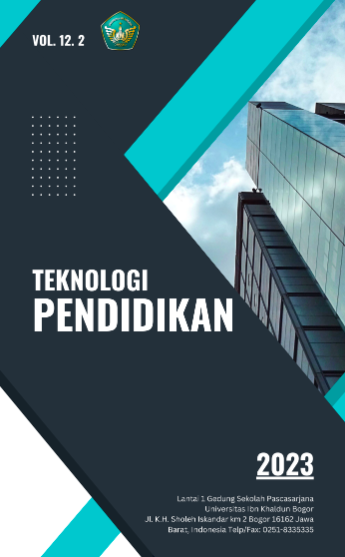Penerimaan dan Penggunaan Open Broadcaster Software dalam Pembelajaran Hybrid dengan Pendekatan TAM 3
Keywords:
Open Broadcaster Software, Pembelajaran Hybrid, TAM 3Abstract
Pembelajaran hybrid merupakan pembelajaran yang menawarkan kesempatan belajar yang menarik kepada mahasiswa dengan menggabungkan media pembelajran tatap muka dengan pembelajaran online. Aplikasi OBS (Open Broadcaster Software) merupakan aplikasi yang menawarkan perangkat lunak gratis yang memungkingkan dosen mengatasi batasan perangkat lunak video conference seperti MS Teams atau Zoom pada pembelajaran hybrid. Oleh karena itu, ada kebutuhan melakukan penelitian mendalam untuk membuat model penelitian dan mengidentifikasi faktor-faktor yang mempengaruhi penerimaan dan penggunaan OBS (Open Broadcaster Software) oleh dosen dalam pembelajaran hybrid. Model yang diajukan dalam melakukan penelitian ini adalah TAM 3 (Technology Acceptance Model 3). Berdasarkan hasil temuan penelitian menggunakan SEM-PLS, dapat diketahui bahwa dari 7 hipotesis penelitian, ditemukan 6 hipotesis penelitian yang diterima dan 1 lainnya ditolak. Diketahui bahwa faktor sikap ditemukan hanya faktor persepsi kemudahan yang memiliki hubungan positif dan signifikan. Sementara, faktor persepsi kemudahan dan kegunaan sama-sama di pengaruhi oleh faktor computer self-efficacy. Selanjutnya, faktor sikap pengguna OBS mampu mendorong niat berperilaku dan berimplikasi pada penggunaan aplikasi OBS.
References
Alfadda, H. A., & Mahdi, H. S. (2021). Measuring students' use of zoom application in language course based on the technology acceptance model (TAM). Journal of Psycholinguistic Research, 50(4), 883-900.
Al Kurdi, B., Alshurideh, M., Salloum, S., Obeidat, Z., & Al-dweeri, R. (2020). An empirical investigation into examination of factors influencing university students' behavior towards elearning acceptance using SEM approach.
Bentler, P. M., & Bonett, D. G. (1980). Significance tests and goodness of fit in the analysis of covariance structures. Psychological bulletin, 88(3), 588.
Bubou, G. M., & Job, G. C. (2020). Individual innovativeness, self-efficacy and e-learning readiness of students of Yenagoa study centre, National Open University of Nigeria. Journal of Research in Innovative Teaching & Learning.
Cakır, R., & Solak, E. (2015). Attitude of Turkish EFL learners towards e-learning through tam Model. Procedia-Social and Behavioral Sciences, 176, 596-601.
Ejdys, J. (2021). Factors affecting the adoption of e-learning at university level. WSEAS Transactions on Business and Economics, 18, 313-323.
Eroglu, A., & Ozdemir, G. (2007). An economic order quantity model with defective items and shortages. International journal of production economics, 106(2), 544-549.
Fahmi, M. A., Kostini, N., & Putra, W. B. T. S. (2022). Exploring hybrid learning readiness and acceptance model using the extended TAM 3 and TPB approach: An empirical analysis. International Journal of Research in Business and Social Science (2147-4478), 11(8), 321-334.
Ghozali, I & Latan, H. (2015). Partial Least Square Konsep Teknik dan Aplikasi Menggunakan Program SmartPLS 3.0 (2nd Edition). Semarang: Badan Penerbit Universitas Diponegoro.
Hair, J. F., Sarstedt, M., Hopkins, L., & Kuppelwieser, V. G. (2014). Partial least squares structural equation modeling (PLS-SEM): An emerging tool in business research. European Business Review, 26(2), 106–121. http://doi.org/10.1108/EBR-10-2013-0128
Hair, J. F. J., Hult, G. T. M., Ringle, C., & Sarstedt, M. (2017). A Primer on Partial Least Squares Structural Equation Modeling (PLS-SEM). Long Range Planning. http://doi.org/10.1016/j.lrp.2013.01.002.
Henseler, J., Ringle, C. M., & Sarstedt, M. (2015). A new criterion for assessing discriminant validity in variance-based structural equation modeling. Journal of the Academy of Marketing Science, 43(1), 115–135. http://doi.org/10.1007/s11747-014-0403-8.
Hu, L. T., & Bentler, P. M. (1998). Fit indices in covariance structure modeling: Sensitivity to underparameterized model misspecification. Psychological methods, 3(4), 424.
Ibrahim, R., Leng, N. S., Yusoff, R. C. M., Samy, G. N., Masrom, S., & Rizman, Z. I. (2017). E-learning acceptance based on technology acceptance model (TAM). Journal of Fundamental and Applied Sciences, 9(4S), 871-889.
Kristandl, G. (2021). "All the world'sa stage”–the Open Broadcaster Software (OBS) as enabling technology to overcome restrictions in online teaching. Compass: The Journal of Learning and Teaching at the University of Greenwich, 14(2), 1-16.
Lestari, A. F., Amalia, H., & Puspita, A. (2021). Penerimaan Teknologi Zoom Cloud Meeting terhadap Minat Belajar Siswa Dari Rumah Dengan TAM. INOVTEK Polbeng-Seri Informatika, 6(1), 27-36.
Ramayah, T., Jasmine, Y. A. L., Ahmad, N. H., Halim, H. A., & Rahman, S. A. (2017). Testing a Confirmatory model of Facebook Usage in SmartPLS using Consistent PLS. International Journal of Business and Innovation, 3(2), 1–14.
Riyath, M. I. M., & Rijah, U. L. M. (2022). Adoption of a learning management system among educators of advanced technological institutes in Sri Lanka. Asian Association of Open Universities Journal, (ahead-of-print).
Senaratne, S. I., Samarasinghe, S. M., & Jayewardenepura, G. (2019). Factors affecting the intention to adopt m-learning. International Business Research, 12(2), 150-164.
Singh, J., Steele, K., & Singh, L. (2021). Combining the best of online and face-to-face learning: Hybrid and blended learning approach for COVID-19, post vaccine, & post-pandemic world. Journal of Educational Technology Systems, 50(2), 140-171.
Thongsri, N., Shen, L., & Bao, Y. (2020). Investigating academic major differences in perception of computer self-efficacy and intention toward e-learning adoption in China. Innovations in Education and Teaching International, 57(5), 577-589.
Weng, C., Tsai, C. C., & Weng, A. (2015). Social support as a neglected e-learning motivator affecting trainee's decisions of continuous intentions of usage. Australasian Journal of Educational Technology, 31(2).
Wong, K. K. K. (2019). Mastering partial least squares structural equation modeling (PLS-Sem) with Smartpls in 38 Hours. IUniverse.
Downloads
Published
How to Cite
Issue
Section
License
Copyright (c) 2023 Jurnal Teknologi Pendidikan

This work is licensed under a Creative Commons Attribution-NonCommercial 4.0 International License.



















